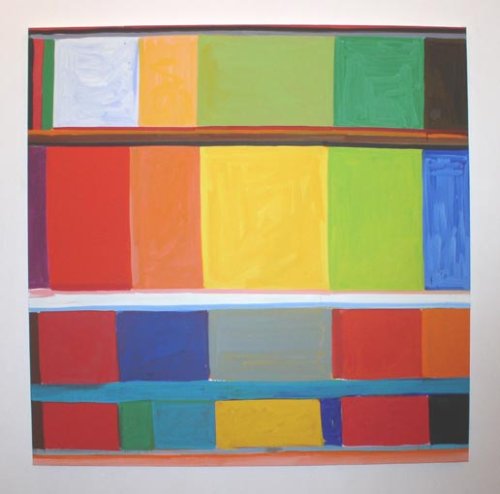Stanley Whitney
dal 11/3/2005 al 16/4/2005
Segnalato da
11/3/2005
Stanley Whitney
Esso Gallery, New York
The artist ''once said that painting is discontinuous, that is not 'deposited' according to his whishes, but rather acts in some special way to reveal his wishes differently from how he expected, with a sort of gap. His canvases cut through the observer's horizon, imposing on him a reality which is both expected and unexpected'' T. Ottavio Camenzio

New Paintings
Jennifer Bacon and Filippo Fossati are pleased to announce the opening Saturday, March 12, 2005 from 6 to 8 p.m. of the first solo exhibition at Esso Gallery by American painter Stanley Whitney.
(...) In 1991 Stanley Whitney published a short book about his work, he included a statement by poet Norma Cole which today looks like a farsighted and perfect explanation of his past and future developments: "hesitation becomes rhythmic assertions, a dance step into the recognizable system of moves called the physical lyric. In its transgression of its own system, each painting questions assumptions about generalization... The paintings refer to one another participating in an on-going conversation about color relations, drawings, placement, illusion, volume, surface...in their own time."
Today critics are returning to the question of painting, sometimes missing the crux of the matter, of painting itself, of the very act of painting; maybe attention will again be paid to the manner of painting, from within the picture.
What is painting then? In the book that I mentioned, Norma Cole referred to painting as a series of operations. Now, there are obviously many ways of carrying out these operations even without using canvas, brushes, and so on. And yet Stanley Whitney uses both canvas and brushes; a well defined, "closed" space, to tell us that his means are specific to painting. Consequently, he withdraws on tiptoe before the picture and instead of being an actor, he disappears, retires into the wings. To say the word "painting" implies a choice. Maybe that is precisely what makes Stanley Whitney's work so different from others which appear similar.
What I mean is that his canvases present an image which does not absorb in its composition the situation of whoever creates it or looks at it, but is more like something else, a different feeling, a feeling of time, rythm, music, a feeling of otherness, an object which at one and the same time is yours and is not yours.
Stanley Whitney once said that painting is discontinuous, that is not "deposited" according to his whishes, but rather acts in some special way to reveal his wishes differently from how he expected, with a sort of gap. Stanley Whitney tends, in his operations, to specify a fact; and the resulting intensity shuffles the cards in the pack. His canvases cut through the observer's horizon, imposing on him a reality which is both expected and unexpected, already realized and yet not realized.
But maybe there is still a simpler way of putting it, as in this quotation from Ernest Ansermet (1948) "In the score, the performer will never find more than an indication of the motive tensions which he must produce. He must strive always to be beyond the mere notes, never actually playing just what is written - also he must never play anything which does conform to what is written."
Before in Italy we were speaking about manipulation and dream and here once again Bachelard turns up to conclude the circle: "Je manipule - dit l'Alchimiste. - Non, tu rêves. - Je rêve, dit Novalis. - Non, tu manipules"(...)
Extract from the essay by Teresio Ottavio Camenzio in Correspondences © Sanpierdarena Editori (GE) Italy 2005
Stanley Whitney was born in 1948 in Philadelphia, PA.
He studied at Columbus College of Art & Design in Ohio, at Kansas City Institute in Missouri and at Yale University in New Haven. Stanley Whitney lives and works in New York and Solignano, Italy. His works have been featured in numerous exhibitions since the early seventies. Museum exhibitions include the Aldrich Museum of Contemporary Art, the Studio Museum in Harlem, the Brooklyn Academy of Music, the Alternative Museum and Franklin Furnace in New York, the Pennsylvania Academy of Fine Arts, Philadelphia, PA, the University of Dayton, Dayton, Ohio. Private galleries include Peg Alston Gallery, Jack Tilton Gallery, Bill Maynes Gallery and Esso Gallery in New York; Christine Koenig Galerie, Vienna, Austria; Magazzino Arte Moderna and Galleria A.A.M. in Rome, Italy, radioartemobile, Utopia Station, created by Zerynthia Rome for Venice Bienniale 2003, and the Dakar Biennal, 2004, among others. He is the recipient of John Guggenheim Fellowship and Pollock-Krasner Fellowship.
Opening Saturday, March 12, 2005 from 6 to 8 p.m.
In the backroom installation by Maurizio Pellegrin and works by Julian Dashper - Francesco Lauretta - Conrad Marca Relli - Curtis Mitchell - Nzingah Muhammad - Florio Puenter - Maurizio Vetrugno - William Villalongo
Esso Gallery
531 West 26th Street 4th floor
New York
Hours: Tuesday through Saturday, 11 am - 6 pm



